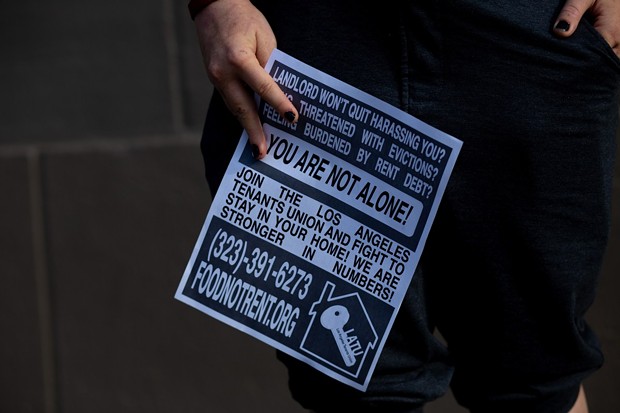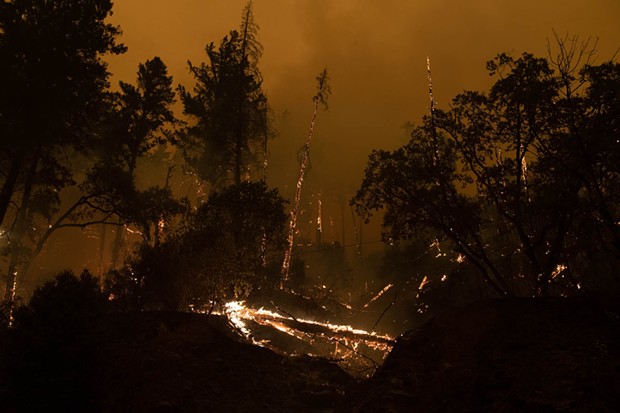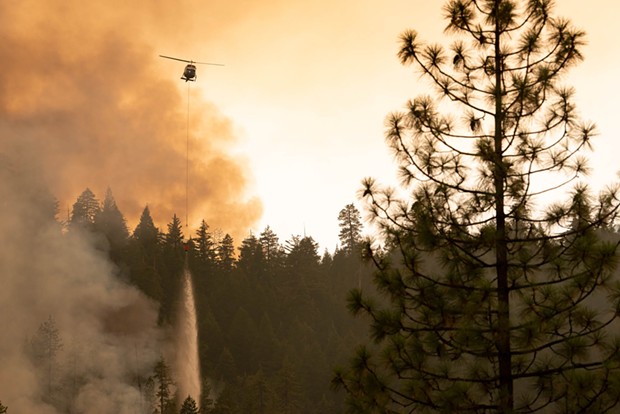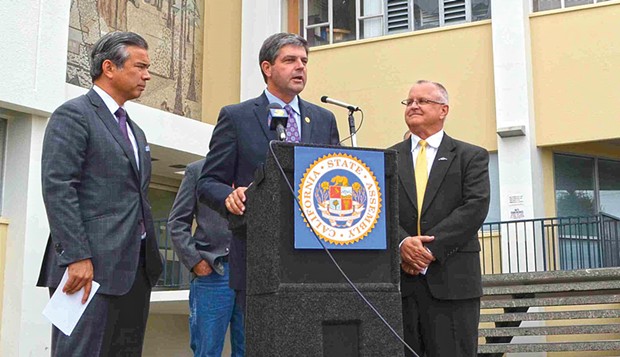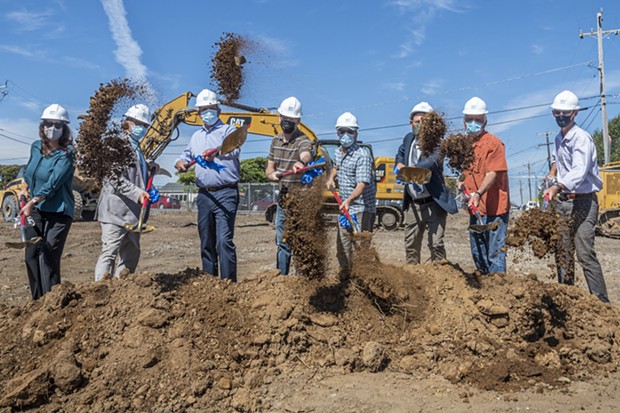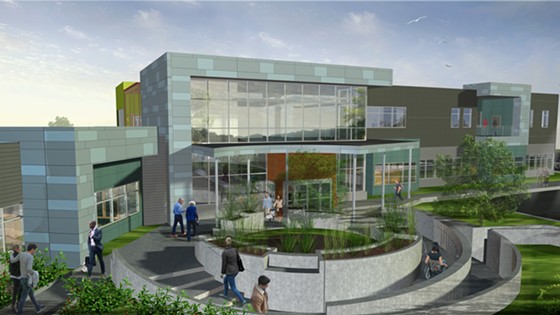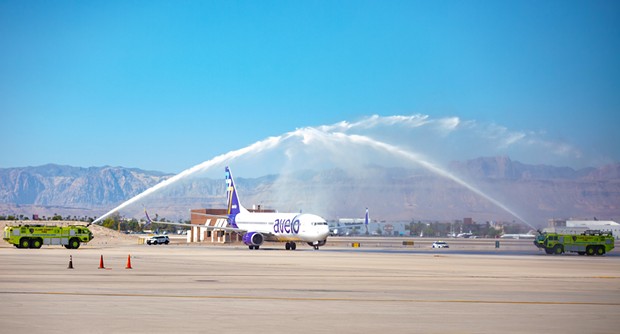Monday, September 27, 2021
California Still Won’t Make COVID-19 Workplace Outbreaks Public
Posted By Melissa Montalvo/CalMatters on Mon, Sep 27, 2021 at 8:54 AM
In February, Assemblymember Eloise Gómez Reyes, D-San Bernardino, proposed a law requiring the California Department of Public Health to report COVID-19 outbreaks by workplace location, meaning outbreaks at specific businesses would be disclosed to the public.
But that requirement was dropped from the bill’s final version, allowing companies — and public health officials — to withhold coronavirus outbreak information from the public. Instead, health officials will report infections by industry.
Worker advocates say this leaves workers and the public vulnerable and in the dark.
“Public disclosure of this data shouldn’t be as contentious as it is,” said Ana Padilla, executive director at UC Merced Community and Labor Center.
Some say COVID-19 reporting requirement was ‘overreach’
The new bill was supposed to build upon last year’s Assembly Bill 685, which was inspired in part by a joint investigation by CalMatters and The Salinas Californian for the California Divide on unreported COVID outbreaks among guest farmworkers. That bill requires employers to notify workers of COVID-19 outbreaks and allows Cal/OSHA to fine employers and shut down workplaces for serious coronavirus violations and outbreaks.
In an interview last year with The Bee, Reyes said that the original goal was that “individual worksite outbreaks would be publicly reported by the Department of Public Health.” But the final version only required the state to report the total number of outbreaks by industry sector — without naming employers.
Her follow-up legislation, Assembly Bill 654, was supposed to clarify this point.
But the bill faced opposition from Assembly Republicans and business groups, such as the California Chamber of Commerce and Western Growers.
The final version removed the individual worksite outbreak reporting requirement when it failed to get enough votes to pass the Assembly in June. There were 22 “no” votes, primarily from Republican lawmakers.
Assemblymember Jim Patterson, who represents parts of Fresno and Tulare counties, said he supported removing the requirement because it eliminated what he called public shaming” language.
“It was the excessive overreach of the bill,” said Patterson.
Reyes’ office didn’t comment on the removal of the language about individual worksite outbreak reporting requirements. “We will continue to seek solutions that protect workers during the COVID-19 pandemic or any future pandemics,” according to a statement.
Assemblymember Adam Gray, D-Merced, also voted against the workplace reporting requirement. He could not be reached for comment.
Should California companies publicly report COVID-19 outbreaks?
Padilla said that a lack of explicit workplace outbreak requirements should “concern” the public. Outbreak data is crucial to keeping communities safe.
“We need the data to mitigate the spread of COVID in real-time, in particular in workplaces,” said Padilla. “We also need workplace data to inform the development of policies that can improve working conditions and potentially save worker lives.
“By prohibiting the publication of data that tells us where outbreaks are happening, we’re limiting our ability to understand the quickly changing and really dangerous virus,” said Padilla.
Padilla pointed to the COVID-19 outbreak at the Foster Farms plant in Livingston last year, where the plant had a 40 percent COVID-19 positivity rate. In a September 2020 Merced County Board of Supervisors meeting, health department officials confirmed this was over eight times higher than the COVID-19 positivity rate in Merced County at the time.
“It was eight times higher than the county’s own positivity rate, and still, they were pointing the fingerat the community, saying ‘it’s the community spread,’” said Padilla.
Foster Farms responded to the comments on their COVID-19 response and outbreak reporting.
“Foster Farms has performed over 130,000 COVID-19 tests in California — more than 80,000 in Merced County — with an overall positivity rate of less than 1 percent, and has provided all of this data to the state of California,” said Ira Brill, vice president of communications for the poultry plant.
“Foster Farms has provided, and continues to provide, its workforce with information about COVID-19 and vaccinations in multiple languages, including Spanish and Punjabi. These are the facts,” Brill said.
Foster Farms wasn’t the only central San Joaquin Valley company to have its COVID protections scrutinized during the earliest months of the pandemic.
Last year, workers at Fresno’s Amazon warehouse criticized the company’s infection reporting policies, saying workers received only vague information about possible exposures and infection numbers.
According to an analysis by UC Merced, most workers who have died of COVID-19 in California’s top 10 high-risk industries were primarily from Latino and immigrant backgrounds. These industries include warehousing, agriculture, and food processing.
“I think the people in the state Capitol that were busy negotiating away the crucial provisions in the bill … don’t share the same background as the low-wage workers of color” who have been disproportionately impacted by the pandemic, said Padilla.
She said she hopes to see another iteration of the bill that requires workplace outbreak data by industry, by county, by employer. Gov. Gavin Newsom has until Oct. 10 to sign or veto the bill.
This article is part of the California Divide, a collaboration among newsrooms examining income inequality and economic survival in California.
Saturday, September 25, 2021
Contractor’s Deal on California Rent Relief Gets more Lucrative
Posted By Manuela Tobias on Sat, Sep 25, 2021 at 6:27 AM
The contract with Horne LLP, a Mississippi-based accounting firm that specializes in disaster relief, jumped from $51.7 million when the program kicked off in March to at least $146.8 million in the amended agreement signed on Sept. 16, according to documents obtained by CalMatters through a public records request.
Under the new contract, which goes through March 2022, Horne will be responsible for administering $2.6 billion in rent relief, up from $1.15 billion when the program kicked off in March.
The increase follows the doubling of federal rental relief funds for California to $5.2 billion and the decisions by several big cities, including Los Angeles and San Francisco, to hand over their local rent relief programs to the state, according to Geoffrey Ross, deputy director at the California Department of Housing and Community Development.
Ross said the cities previously administering their own programs joined the state because of increased efficiencies; for example, the state can easily redistribute funds if one city or county has leftover money. He also said that local officials saw the state’s success with its contractor.
Horne, which has made emergency rent relief a line of business, isn’t in charge of distributing all the money that California has. The remainder of the $5.2 billion available for rent relief is being handled by local jurisdictions that are still disbursing the first round of funds, including Los Angeles, and those running their own programs for the second round, including Sacramento, Stockton, San Diego, Oakland and Alameda.
The amount that the state, and Horne, handles could increase if local jurisdictions also choose to hand over their program to the state, or if California gets anticipated leftover federal funds from other states.
But State Auditor Elaine Howle warned last week that California could lose as much as $337 million in federal rent relief because of how it reports spending to the feds. The Housing and Community Development Department disputes that will happen.
While the state bumped up Horne’s administrative fees in the renewed contract, it amounts to about 5%percent of the total rental assistance allotment — and still falls under the federal government’s 15 percent cap for administrative fees.
“Even though it’s a sizable amount of money, we’re able to actually now deploy additional resources,” Ross told CalMatters. “We have a pretty significant cost savings when you were to compare what it would cost for all 49 jurisdictions to run this center.”
Most of what Horne is receiving will go to staffing, which Ross said the company had already quadrupled, to about 1,200 employees, since the start of the program.
In September, the contract calls for at least 1,190 people to manage individual cases, 340 people to staff the call center and 19 people to manage funds. The staffing is supposed to drop off in November, to 650 case managers and 190 call center workers, and even more so by March.
“Even though it’s a sizable amount of money, we’re able to actually now deploy additional resources.”
Geoffrey Ross, deputy director at the California Department of Housing and Community Development
If the state decides additional staffing is needed, the contract says Horne would provide 200 more employees within three weeks at an additional cost of $4 million a month to the state.
The money budgeted to pay Horne could technically be redirected to landlords and tenants if they use less staffing than predicted, Ross said.
Lots of big contracts
This is only one of a multitude of contracts worth tens of millions of dollars the state has signed with outside vendors in response to emergency needs related to the COVID-19 pandemic. They include several to fix problems with unemployment benefits getting to jobless Californians. Some other deals have had problems.
Ross said the state had received multiple bids for this contract, and determined that Horne was the most qualified because of its expertise in disaster relief, including rent relief in Texas. While that rollout also started slowly, it has improved, according to media reports.
The state of California was unprepared to create the software or hire employees to get the money out in time before it started to be clawed back by the feds, Ross said.
“It is really hard to fully understand what’s the appropriate dollar amount for these kinds of things, particularly, to be honest, of a program of a scale and speed, which is fairly unprecedented,” said Vincent Reina of the University of Pennsylvania, whose research group has been studying rent relief distribution in California and Los Angeles.
To evaluate how effective the program has been, Reina said to look at three components: the total dollars distributed, the rate at which distribution has increased and whether the dollars have reached those who need it most. “And that’s where the data becomes really complicated,” he said.
This week, the state announced it has paid out $584.8 million to nearly 50,000 households, about a quarter of the $2.6 billion available. That’s a nearly 700 percent increase since June 28, when the state began the latest round of tenant protections, according to Russ Heimerich, a spokesperson for the state’s Business, Consumer Services and Housing Agency.
Ross attributed the faster rollout to eased federal documentation requirements, which led to simpler applications, and an increase in how much landlords and tenants are eligible to receive.
While the eviction protections passed in June are set to expire on Sept. 30, rental assistance will continue to be available. To be covered by eviction protections through next March, eligible tenants must apply for rent relief.
“When an eviction matter comes before the court, the court is supposed to ask the landlord: ‘Have you participated in rent relief and has your tenant participated in rent relief?’ If the answer is yes, then the courts cannot take up the eviction matter until that case is decided,” Heimerich said.
Horne and the housing department are working on a separate phone line courts could call to corroborate whether a plaintiff in an eviction case had applied for rental assistance, Heimerich said.
A landlord gets relief, finally
One landlord, Bill Phelps, told CalMatters he had on Monday finally received nearly $35,000 in missed rent payments for the 4-bedroom, 3-bathroom house he rents out for $3,500 a month in Concord. But he had applied for the money six months earlier, on March 15, the day the state opened its portal.
“It was a long, long, long wait, but I’m happy to get the money,” said Phelps, 72.
But he said his tenants, an unemployed couple with two kids who lost their jobs at the start of the pandemic, still plan to move in with family at the end of the month because they’re $7,500 behind in rent.
“I talked to the tenants and said, ‘The moratorium ends at the end of the month. You’re going to have to leave. I don’t want to start an eviction,’” Phelps told CalMatters. “That’s where I made the offer: I’ll forgive the $7,500 you owe if you’re out by the end of the month. I even kicked in $200 if they need it.”
Ross said money was still available and encouraged landlords and tenants to apply for rent through December to avoid having to leave. But they have to wait 15 days between the day they receive rental assistance, and their next application.
Phelps said he didn’t know that was an option, and would consider it. But he has little faith.
“If I would get my check right away, oh yeah, they can stay,” he said. “But the way that it is, I wouldn’t be getting this money until maybe next July or August. I’ll just sort of accept my losses, and just move forward and sell the house.”
Friday, September 24, 2021
Public Health: Of 12 COVID-19 Hospitalizations This Week, 11 Were Unvaccinated
Posted By Thadeus Greenson on Fri, Sep 24, 2021 at 4:23 PM
Humboldt County Public Health confirmed 23 new COVID-19 cases and two new hospitalizations today but, for the first time in more than a week, did not report a COVID-19 death locally.
A state database shows 24 people currently hospitalized with COVID-19 locally, with two under intensive care. The local hospital census peaked Sept. 3 with 42 COVID-19 patients before a steadily decline over the next couple weeks. The census is creeping back up, however, as a total of 17 COVID-19 patients were hospitalized as of Monday and there are currently 24.
"The county has seen a slight improvement in the cases and hospitalization rates, but local health officials caution that both metrics are still higher than at any point before August, the deadliest month of the pandemic," a press release states.
Today's cases — which make 259 confirmed so far this week — were reported after laboratories processed 394 samples with a test-positivity rate of 7.4 percent. After recording a test-positivity rate of 10.1 percent in July — the highest for any month since the pandemic began — the rate in Humboldt County jumped to 15.9 percent in August. Through the first 24 days of September, it sits at 15.8 percent, far outpacing state (3.1 percent) and national (8.1 percent) rates.
Lightning Could Spark more California Fires as World Warms
Posted By Julie Cart, CalMatters on Fri, Sep 24, 2021 at 11:35 AM
The worry is not being struck by a bolt, although it can be deadly. Instead, their primary concern is that lightning, slashing down in remote areas, can trigger unseen fires that smolder for days before they flare up, bursting into a dangerous and difficult-to-fight wildfire.
In August 2020, a remarkable barrage of lightning in Central and Northern California spawned more than 15,000 strikes over a few days, igniting more than 600 fires and burning more than 2 million acres. Five simultaneous lightning-sparked fires destroyed thousands of homes and buildings and claimed the lives of at least seven people.
And this month, lightning ignited a nasty, uncontained fire that is still menacing groves of ancient sequoia trees in Sequoia-Kings National Park.
It’s starting to look like a preview of the future: As climate change continues to alter the landscape, particularly in the West, scientists warn that lightning strikes capable of igniting wildfires are expected to multiply.
One study predicts that lightning strikes nationwide will increase 12 percent for every degree Celsius of global warming and about 50 percent over the 21st century if people keep emitting planet-warming greenhouse gases at the current pace. Other studies over the past three decades have predicted similar effects of climate change.
“The evidence from looking at climate models is that we can expect that lightning will increase,” said David Romps, who directs the Berkeley Atmospheric Sciences Center and co-authored the study. “My best guess is that by the end of the century — if we continue to burn coal and fossil fuels — we anticipate an increase of the number of lightning strikes by 50 percent.”
One study predicts that lightning strikes nationwide will increase 12 percent for every degree Celsius of global warming.
Lightning plays an outsized role in wildfires: More than 40 percent of wildfires in the West, largely in places other than California, were caused by lightning, and those fires accounted for more than 70 percent of the acreage burned between 1992 and 2015, according to the U.S. Forest Service.
“Lightning is so dangerous, usually it stays pretty much on the east side of the state, but last year it was all over the place, including the Coast Range,” said David Carle, whose book, Introduction to Fire in California, is a primer on the subject. “I think we have learned that dry lightning storms are a real problem.”
The strangeness of last year’s lightning-sparked fires — striking in coastal ranges unaccustomed to electrical storms — was underscored by the absence of rain, meaning that powerful natural energy hit the ground precisely where overgrown, dry vegetation waited, with no rain to quench the sparks.
“Dry lightning — it’s what everybody fears,” said Paul Steblein, a fire science coordinator with the U.S. Geological Survey.
Lightning strikes difficult to model
There’s little debate that climate change is driving larger and more frequent fires. But so far, scientists have not yet seen an increase in lightning events.
“I’ve looked at lightning trends over the last 25 years, and there hasn’t been a noticeable increase in global lightning or U.S. lightning,”said Chris Vagasky, a meteorologist who monitors lightning for Vaisala, a Finnish company that operates a vast U.S. network of lightning sensors, providing research and real-time data to governmental agencies and private companies.
Because lightning is caused by hyper-local, highly transitory factors, such as winds, it’s difficult for scientists to tease out patterns or project the future. “Lightning itself is such a small process that it can’t be modeled explicitly at climate scales,” Vagasky said.
Lightning is created by static electricity in clouds, as ice droplets bump into each other and cause friction, heating the air in the cloud to as high as 54,000 degrees. About 80% of the time, lightning explodes from cloud to cloud, crackling and snapping in the upper atmosphere in thunderclouds that can rise 10 miles.
Last year, some 170 million lightning strikes occurred across the country, about 22 percent below average; California was 51 percent below average with 283,000 strikes, despite the deadly August 2020 surge. This year, nationwide strikes are trending about 15-20 percent below average, Vagasky said.
California does not rank among the top ten for lightning strikes: Texas, Florida and Oklahoma, where warm, moist air spends the summer, are the leaders. While lightning can set grass fires in those states, the repercussions are nothing like California’s expansive, destructive and deadly wildfires.
Still, the Golden State has a history of catastrophic fires sparked by lightning storms. In the Siege of ’87, lightning assaulted the California-Oregon border for two weeks, setting off as many as 4,000 fires. Lightning-sparked fires in 1999 also merged in Big Sur into a massive conflagration, and more than 5,000 strikes over a day and a half set off about 1,000 fires in 2008.
Fighting unpredictable lightning fires
While less lightning in California over the past two years is good news for fire commanders, the scientists’ projections of an increase in coming decades are sobering: This year’s stubborn drought and record heat mean that lightning strikes are particularly dangerous.
“There are some lightning strikes in these conditions where you have immediate fire activity,” said Anthony Scardina, deputy regional forester for the U.S. Forest Service. “In other instances, the strike may not show a flame for 72 hours. It could hit a single tree, and in the right environment, it could flame up later and grow. The fire is out there, hiding.”
Lightning “could hit a single tree, and in the right environment, it could flame up later and grow. The fire is out there, hiding.”
Anthony Scardina, U.S. Forest Service
Such blazes are known as “holdover fires,” said Robyn Heffernan, a federal meteorologist working at the National Interagency Fire Center in Boise, Idaho, the nerve center for U.S. wildland firefighting. “When there are thunderstorms and lightning events, we know that these small fires can be out there and we look for them.”
Another complicating issue with lightning-caused fires is the unpredictability of their location. Lightning can strike as far as 20 miles away from the thunderstorm that generated them. Human-caused fires, which account for about 95% of wildfires in California, tend to start near people or equipment, generally within reasonable reach of fire crews. But lightning’s caprice means fires can pop up virtually anywhere, in the backcountry or far from firefighters.
Brian Rhodes, the U.S. Forest Service’s deputy director for fire and aviation management, said it’s almost impossible to forecast lightning-sparked fires, calling them a “ wild card.”
“I’ve been working in California my entire career and our weather models really struggle to keep up with predicting these events,” he said.
Understanding weather patterns and lightning risk is a critical piece of fire strategy, so much so that large blazes are assigned fire weather officers who receive special training and certification from the National Weather Service.
This month’s lightning storms in the Bay Area and Southern California lasted less than 12 hours, compared to two days of strikes that triggered the August 2020 fire siege. That siege caught authorities off guard for an array of reasons: the number of strikes, the speed at which the fires spread and converged, and how broadly dispersed the lightning storms were.
The five major lightning-sparked fires all ignited within three days, beginning on Aug. 16, reaching from Monterey Bay north to the Oregon border. In the end, lightning storms had spawned California’s first “gigafire,” a single blaze that grew to more than a million acres.
One of the biggest fires — the CZU August Complex fire north of Santa Cruz — was sparked by lightning around 3 a.m on a Sunday, on Aug. 16. By noon, 22 fires were detected, 15 of them unstaffed with firefighters.
That same day, lightning sparked the LNU fires, racing through Sonoma, Napa, Lake, Solana and Yolo Counties. Thunderstorms west of Big Sur sparked the SCU Lightning Complex fire that spread over five counties. Then, over the next two days, Butte, Tehama and Glenn Counties were struck with multiple lightning fires that killed one firefighter, and the Sequoia National Forest blew up with a fire that burned nearly 170,000 acres.
Once these multiple fires caught, they moved at a furious rate. Fire authorities had to rush crews from one blaze to another, a deadly and frustrating game of whack-a-mole.
“Resources quickly became scarce,” the 2020 Cal Fire report says. “Requests outnumbered available resources as initial attack activity outpaced available resources. The lightning storm continued across the State into the Pacific Northwest and Great Basin. Demand for available resources across the nation was impacted by multiple major fires in the western United States.”
One of the biggest threats, Rhodes said, was where the lightning siege struck: “A lot of the areas were very remote,” he said, “and it was dry lightning, the worst we can get on fires.”
Thursday, September 23, 2021
HumCo Records Four More COVID-19 Deaths, 40 New Cases as Hospitalizations Rise
Posted By Thadeus Greenson on Thu, Sep 23, 2021 at 4:18 PM
Four more Humboldt County residents have died of COVID-19, Public Health reported today, while also confirming 40 new cases of the virus and four new hospitalizations.
This is the fifth consecutive day Public Health has reported a new COVID-19 death, with 10 local deaths reported over the past seven days and 40 since Aug. 1.
A state database shows 25 people currently hospitalized with COVID-19 locally, with four under intensive care. The local hospital census peaked Sept. 3 with 42 COVID-19 patients before a steadily decline over the next couple weeks. The census is creeping back up, however, as a total of 17 COVID-19 patients were hospitalized as of Monday and there are currently 25.
Today's cases — which make 236 confirmed so far this week — were reported after laboratories processed 377 samples with a test-positivity rate of 10.6 percent. After recording a test-positivity rate of 10.1 percent in July — the highest for any month since the pandemic began — the rate in Humboldt County jumped to 15.9 percent in August. Through the first 20 days of September, it has jumped to 16.3 percent, far outpacing state (3.1 percent) and national (8.1 percent) rates.
Governor Signs Wood's Wildfire Prevention Bill
Posted By Thadeus Greenson on Thu, Sep 23, 2021 at 1:51 PM
“It is clear that we cannot firefight our way out of this wildfire crisis,” Wood said in a press release. “California needs both a world-class firefighting force and a world-class fire preparedness and mitigation force with the resources to meet the crucial task at hand.”
Under the bill, Assembly Bill 9, eight existing programs and duties focused on community fire prevention, preparedness and mitigation efforts currently under CalFire's purview will be shifted to this new branch. The new entity will use block grants and work to support regional entities to develop a pipeline of woodland and fuel reduction projects that are part of a coordinated strategy across the region and state.
“What communities need to do to prevent and prepare for catastrophic wildfire varies tremendously across this diverse state,” said Wood. “Housing density, vegetation type and topography are just a few of the many considerations that affect the kinds of work communities must undertake to prepare for the next fire. This bill ensures that strategies be regionally focused to meet the unique needs of each community.”
Open Door Breaks Ground on New Arcata Health Center
Posted By Thadeus Greenson on Thu, Sep 23, 2021 at 12:27 PM
A host of local officials gathered in a dirt lot on Foster Avenue Tuesday afternoon to get their golden shovels dirty and celebrate the groundbreaking of the state-of-the-art Arcata Community Health Center, which is slated to open in 2023.
Once complete, the 33,000 square-foot facility will use a solar array — and an emergency backup generator — to power 35 exam rooms and a laboratory that will treat an estimated 40,000 patients per year — both adults and children — receiving primary care. The center will consolidate Open Door Community Health Centers’ two existing Arcata clinics — North Country Clinic and Humboldt Open Door Clinic — in a facility that meets “the same standards” as Open Door’s new health centers in Crescent City, Eureka and Fortuna.
Nonstop to Vegas
Posted By Thadeus Greenson on Thu, Sep 23, 2021 at 7:52 AM
Avelo Airlines announced this morning that it will begin offering twice weekly nonstop flights from Humboldt County to Las Vegas, Nevada, in November.
“We are excited to add this second popular vacation and entertainment destination to our Eureka/Arcata schedule,” Avelo Chairman and CEO Andrew Levy said in a press release. “Getting to Vegas from the Humboldt Bay Area is now easier and more affordable than ever. The addition of Las Vegas to our existing Los Angeles service demonstrates our commitment to providing more choice and convenient access to the places our customers want to go go at everyday low fares.”
Just how low are those fares? Well, the company says they will start as low as $29 one-way, though that’s for a limited number of seats and “additional fees for carry-on and checked bags, assigned seats and other optional services may apply.”
The flights will operate on Thursdays and Sundays, leaving Humboldt County at 3 p.m. Thursdays (arriving in Vegas at 4:45 p.m.) and returning from Vegas at 5:25 p.m. Sundays (arriving in McKinleyville at 7:25 p.m.). The service begins Nov. 18.
Find the full press release from Avelo here.
Wednesday, September 22, 2021
HumCo Records 89th COVID-19 Death, 35 New Cases
Posted By Thadeus Greenson on Wed, Sep 22, 2021 at 4:14 PM
For the third consecutive day, Public Health is reporting that another Humboldt County resident has died of COVID-19, while also confirming 35 new cases of the virus and two hospitalizations.
The death brings the county's cumulative death toll from the virus to 89, with 36 having come since Aug. 1.
A state database shows 20 people currently hospitalized with COVID-19 locally, with four under intensive care. The slow decline in hospitalizations — which peaked at 42 Sept. 3 — is welcome news for local hospitals, which had been pushed beyond capacity amid a brutal August that saw 2,000 new cases confirmed, 98 hospitalizations and 22 deaths.
Today's cases — which make 196 confirmed so far this week — were reported after laboratories processed 289 samples with a test-positivity rate of 12.1 percent. After recording a test-positivity rate of 10.1 percent in July — the highest for any month since the pandemic began — the rate in Humboldt County jumped to 15.9 percent in August. Through the first 20 days of September, it has jumped to 16.7 percent, far outpacing state (2.9 percent) and national (8.1 percent) rates.
Yurok Tribe Nabs $30 Million Education Grant
Posted By Iridian Casarez on Wed, Sep 22, 2021 at 3:53 PM
“The Yurok Education Department is excited about what this grant means for our families, our students and the community as a whole. In partnership with the True North Organizing Network, Del Norte schools, First-5, Del Norte Child Care Council and other local entities, we will build sustainable supports, services and programs that help our students succeed as they make their way from pre-kindergarten to college to a satisfying professional career,” said Jim McQuillen, Yurok Education Department director. "I look forward to establishing the high-quality learning opportunities our students need and deserve."
The DOE’s Promise Neighborhoods grant aims to improve the educational and developmental outcomes of children and youth in distressed communities and to transform those communities.
The grant will be paid over the next five years in the amount of $5,999,644 annually.
The Klamath River Promise Neighborhood looks to bring together tribes, schools, the Del Norte Unified School District and county office of education, community-based organizations, institutes of higher education, local government and parent and resident groups, who intend to improve educational, health and developmental outcomes for children by building a continuum of solutions centered around great schools in Del Norte County and adjacent tribal lands.
North Coast Rep. Jared Huffman applauded the grant award.
"It’s inspiring to see folks across the region come together under the goal of improving students’ lives to secure this grant," he said in a press release. "Del Norte County is one of the most economically disadvantaged regions in my district, but with this funding we can ensure children are healthy, have the tools they need for a successful education, and can go on to have fulfilling careers to support themselves, their communities and Tribes.”
